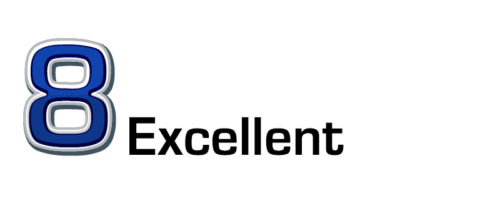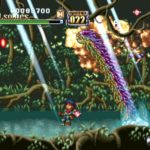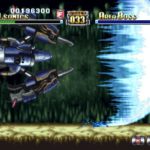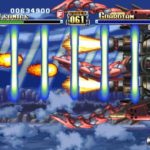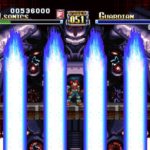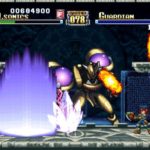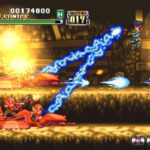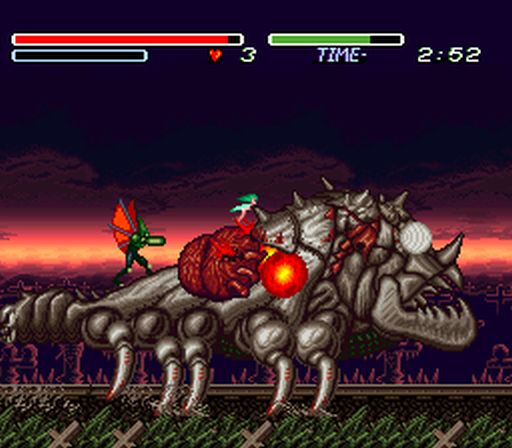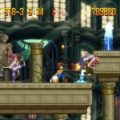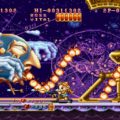Developer: Media Vision Publisher: SCEE Release: 09/29/95 Genre: Action
Gunner’s Heaven holds the distinction of being one of the first PlayStation games I ever read about. Next to Battle Arena Toshinden it seemed like the coolest game in the world. I mean, it is practically a 32-bit Gunstar Heroes! Sadly those of us in America would miss out on the game as Sony hated 2d with a passion. Lucky Europeans would receive the game under the title Rapid Reload. It would be some time before I finally got my hands on it but Rapid Reload turned out to be a pretty good game. It did not live up to my lofty expectations but is still worth a purchase today.
Rapid Reload was originally released early in the PlayStation’s life in 1995 as Gunner’s Heaven. North America would be the only market that missed out as the management at the time had issues with 2d games. Thank god for Europe. The story follows Axel Sonics and Ruka Hetfield as they pursue the magical stone Valkiry. Also in pursuit are the Pumpkin Head gang and it becomes a race to prevent them from capturing the stone for world domination.
The immediate comparisons to Gunstar Heroes are unavoidable. Rapid Reload was inspired by that game and don’t let anyone tell you otherwise. Aside from its weapons you can also use melee attacks and climb on most surfaces. You have a wire adapter to hook and swing where possible aid in that. It is not ever mandatory during gameplay but it does have an unintended benefit; you are invincible while swinging. Abuse the hell out of it!
There are significant gameplay differences that deserve recognition. The choice between Axel and Ruka is more than cosmetic; each has their own weapon load out. Each has four weapons at all times that you can switch at any time. These range from the standard machine gun to homing lasers, flamethrowers, to sonic cannons. Switching is an incredibly crucial element of the game as most scenarios seemed designed around particular weapons. Last but not least you get smart bombs as well.
The weapon system has further nuance due to the power meter. As you defeat enemies they drop gems that raise your power rating. The higher the number, the stronger the attack. Gems come in a few sizes but you will want to keep an eye out for the boost icon. This bad boy boosts (heh) each weapons attack power to ridiculous heights briefly. It’s so strong it can take out minibosses in seconds which is why you’ll almost never get the chance to use it on them.
The action is pretty heavy at times more on screen chaos than would probably be possible on a 16-bit console. More than in its gameplay the level design is where Rapid Reload skews a little too close to Treasure’s classic. We are talking blatant “homages” to the best moments in that game. Stage three is a high speed run through a mining tunnel on rocket powered skates. It looks near identical with the exception of an outdoor segment. Stage two takes place in forest with numerous high powered mecha and flora and fauna. As much as it shamelessly steals from other games it handles it very well. Its highs are high but at its lowest you’ll wish you were playing a better game.
The pacing is where the game stumbles. The power system would suggest a game that is brimming with action at all times to keep you stocked up. Kind of like the video game equivalent of Crank. But most levels feature odd lulls where either no enemies appear or they don’t drop items at all. For the most part it isn’t an issue. But when you die during a boss battle you start at zero which is rough and makes these fights longer than they should be. Treasure manage this aspect better by featuring constant mini boss battles between its bursts of action. Here each level features at least two guardians in addition to the end level boss yet its pauses seem out of place.
The challenge is about median with a few caveats. You have a single life and nine credits which in my opinion is generous. Health items are rare and only appear twice in each stage at most. It sounds rough but in practice plays out differently. You can sustain a large number of hits before death which helps. Once you’ve figured out which weapon to use in each level they become a breeze. The bosses feature easily recognizable patterns and it’s possible to kill most without receiving any damage. Or maybe I’m just that good. Either way the average gamer will not have as much trouble reaching the end than in similar titles like Contra or Metal Slug.
Rapid Reload looks great but surprisingly is not as aesthetically pleasing as similar 16-bit titles. Outside of its color palette and large sprites it is not beyond the realm of the SNES. The presentation is carried by its art direction which is incredibly varied. The European version of the game strips out all of the voice acting during the few cutscenes but they are so short you are not missing anything.
In Closing
Rapid Reload may look like Gunstar Heroes but it lacks the polish that made that game a classic. It makes a great alternative though and with its action and graphics still holds up today.
